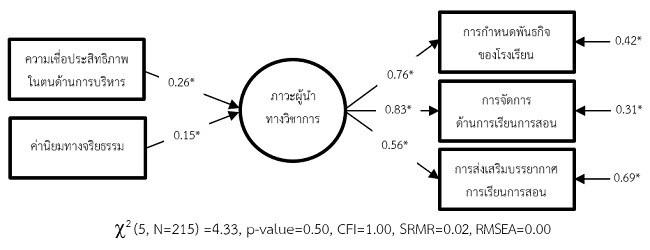“คนเก่งที่เป็นคนดี” โมเดลปัจจัยเชิงสาเหตุของภาวะผู้นำทางวิชาการของผู้บริหารโรงเรียนรุ่นใหม่
DOI:
https://doi.org/10.14456/nrru-rdi.2021.72คำสำคัญ:
ภาวะผู้นำทางวิชาการ, ความเชื่อประสิทธิภาพในตนด้านการบริหาร, ค่านิยมทางจริยธรรมบทคัดย่อ
ในศตวรรษที่ 21 ผู้บริหารสถานศึกษายุคใหม่จะต้องเป็นทั้งผู้นำทางวิชาการและผู้นำจริยธรรมพร้อมกัน จึงนำมาสู่การวิจัยครั้งนี้ที่มีวัตถุประสงค์เพื่อ 1) ศึกษาระดับภาวะผู้นำทางวิชาการ ความเชื่อประสิทธิภาพในตนด้านการบริหารและค่านิยมทางจริยธรรม 2) พัฒนาและตรวจสอบความตรงของโมเดลเชิงสาเหตุ และ 3) ศึกษาอิทธิพลของความเชื่อประสิทธิภาพในตนด้านการบริหาร และค่านิยมทางจริยธรรมที่มีผลต่อภาวะผู้นำทางวิชาการของผู้บริหารสถานศึกษารุ่นใหม่ จำนวน 215 คน โดยสุ่มตัวอย่างด้วยวิธีการตามสะดวก โดยใช้แบบสอบถามแบบประมาณค่า 5 ระดับ ที่มีค่าความเที่ยงเท่ากับ 0.80 และวิเคราะห์ข้อมูลด้วยสถิติเชิงพรรณนา และทดสอบสมมติฐานด้วยการตรวจสอบความตรงของโมเดลเชิงสาเหตุและวิเคราะห์โมเดลมิมิค ผลการวิจัยพบว่า โมเดลเชิงสาเหตุภาวะผู้นำทางวิชาการ มีความสอดคล้องกับข้อมูลเชิงประจักษ์ (2=4.33, p=0.50, CFI=1.00, SRMR=0.02, RMSEA=0.00) ปัจจัยเชิงเหตุด้านความเชื่อประสิทธิภาพในตนด้านการเป็นผู้บริหาร และค่านิยมทางจริยธรรมส่งผลต่อภาวะผู้นำทางวิชาการด้วยขนาดอิทธิพลมาตรฐานเท่ากับ 0.26 และ 0.15 ตามลำดับ และร่วมกันอธิบายความแปรปรวนของภาวะผู้นำทางวิชาการของผู้บริหารโรงเรียนรุ่นใหม่ได้ร้อยละ 9 ดังนั้นหลักสูตรการบริหารการศึกษาควรพัฒนาผู้นำทางวิชาการรุ่นใหม่ที่มีทักษะการบริหารจัดการศึกษาและจริยธรรมวิชาชีพสำหรับผู้บริหารทางการศึกษาเพี่อเป็นต้นแบบที่ดีของครูและนักเรียนต่อไปในอนาคต
References
ÇAlik, T., SezgİN, F., Kavgaci, H., & KilinÇ, A. Ç. (2012). Examination of relationships between Instructional leadership of school principals and self-efficacy of teachers and collective teacher efficacy. Educational Sciences: Theory & Practice, 12(4), 2498-2504.
Chan, T. C., Chandler, M., Turan, S., Kpeglo, S., & Du, R. (2014). Roles and responsibilities of school principals: A five country comparison. The SRCEA Yearbook 2014, Mississippi State University Press. Retrieved October 11, 2021, from https://www.dropbox.com/s/ a4zdh7yo46mx8su/Yearbook2014AdditionFinal.pptx?dl=0
Graduate Division. (2021). Trends of graduate students of College of Education. Retrieved October 1, 2021, from http://sp-grad.edu.ku.ac.th/ (In Thai)
Grissom, J. A., & Loeb, S. (2011). Triangulating principal effectiveness: How perspectives of parents, teachers, and assistant principals identify the central importance of managerial skills. American Educational Research Journal, 48(5), 1091-1123.
Hair, J. F., Black, W. C., Babin, B. J., & Anderson, R. E. (2010). Multivariate data analysis (7th ed.). Upper Saddle River, NJ, USA : Pearson Education.
Hallinger, P. (2010a). A review of three decades of doctoral studies using the principal instructional management rating scale: A lens on methodological progress in educational leadership. Educational Administration Quarterly, 47(2), 271-306.
Hallinger, P. (2010b). Developing instructional leadership. In B. Davies, and M. Brundrett, (eds.). Developing successful leadership (pp. 61-76). Dordrecht : Springer.
Hallinger, P., & Huber, S. (2012). School leadership that makes a difference: International perspectives. School Effectiveness and School Improvement, 23(4), 1-9.
Hallinger, P., & Murphy, J. (1985). Assessing the instructional management leadership behavior of principals. The Elementary School Journal, 86(2), 272-309.
Hallinger, P., & Wang, W. C. (2015). Assessing instructional leadership with the principal instructional management rating scale. Hong Kong : Springer International Publishing.
Halpern, C., Szecsi, T., & Mak, V. (2021). “Everyone can be a leader”: Early childhood education leadership in a center serving culturally and linguistically diverse children and families. Early Childhood Education Journal, 49(4), 669-679.
Hughes, W., & Pickeral, T. (2013). School climate and shared leadership. Retrieved October 11, 2021, from https://schoolclimate.org/wp-content/uploads/2021/05/sc-brief-leadership.pdf
Jansopa, N. (2015). Needs analysis in instructional leadership development for primary school administrators. Thesis, Master of Education Program in Educational Administration, Chulalongkorn University, Bangkok. (In Thai)
Joreskog, K. G., & Goldberger, A. S. (1975). Estimation of a model with multiple indicators and multiple causes of a single latent variable. Journal of the American Statistical Association, 70(351), 631-639.
Kelloway, E. K. (1998). Using LISREL for structural equation modeling: A researcher's guide. CA : Sage Publication.
Lambert, L. (2002). The constructivist leader. New York : Teachers College Press.
Liu, S., & Hallinger, P. (2018). Principal instructional leadership, teacher self-efficacy, and teacher professional learning in China: testing a mediated-effects model. Educational Administration Quarterly, 54(4), 501-528.
Ministry of Education. (2007). Guidelines for educational decentralization, administration and management in the year 2007. Retrieved October 11, 2021, from http://backoffice.oneco.th/uploaded/Category/Laws/RuleMetDistEdMnt2550-02-12-2010.pdf (in Thai)
Nanthachai, S. (2011). Professional ethics for educational administrator. Bangkok : Samchareon Publishing. (in Thai)
Rosseel, Y. (2012). lavaan: An R package for structural equation modeling. Journal of Statistical Software, 48(2), 1-36.
Schrag, F. (1979). The principal as a moral actor. In D.A. Erickson, and T.L. Reller. (eds). The principal in metropolitan schools (pp. 208-232). CA : McCutchan Publishing.
Sebastian, J., Allensworth, E., Wiedermann, W., Hochbein, C., & Cunningham, M. (2019). Principal leadership and school performance: An examination of instructional leadership and organizational management. Leadership and Policy in Schools, 18(4), 591-613.
Sripetchdee, N., & Kiatwateeratrana, T. (2018). Vicharn Panit: How to learn and when to change. Retrieved October 11, 2021, from https://thepotential.org/knowledge/prof-vicharn-panich/ (In Thai)




